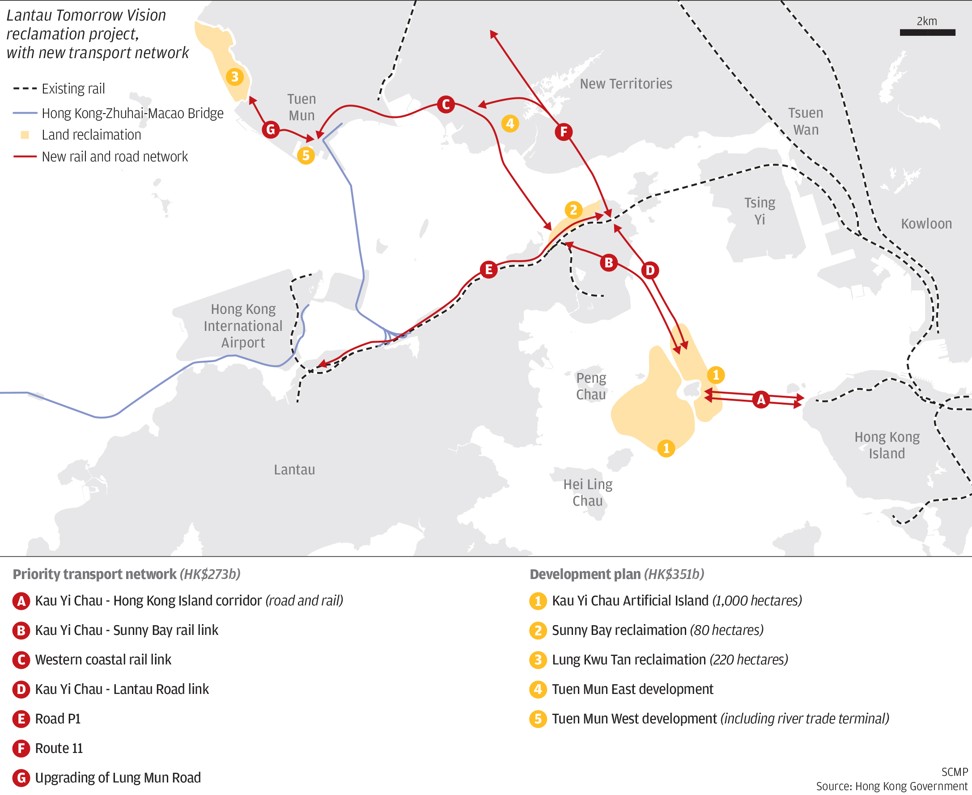
Qianhai Authority plans for high-speed rail extension linking Lantau reclamation to Shenzhen economic zone – without telling Hong Kong
- Mainland exhibition centre for pilot development site splashes proposal on transport system map for bay area, without official announcement
- Hong Kong authorities deny concealing plan and say there are no intentions to build link
Authorities of an economic zone in Shenzhen have made plans for an extension of the cross-border high-speed rail that would connect to a proposed Hong Kong metropolis of artificial islands – without telling their counterparts.
The Qianhai Authority has not officially revealed the move, but plans for it have quietly been on display on the ground floor of an official exhibition centre for the pilot development zone. The concept was splashed across a “transport system map” depicting the “Greater Bay Area”.
Under the bay area scheme, the Chinese government intends to link Hong Kong, Macau, Shenzhen and eight other mainland cities into an economic and innovation powerhouse.
In the map, the local section of the Guangzhou-Shenzhen-Hong Kong Express Rail Link that opened in the West Kowloon terminus last year would branch out to the East Lantau metropolis, run through the New Territories and cross the border to Qianhai, joining the national network.
The East Lantau plan, also known as the Lantau Tomorrow Vision, centres on man-made islands that would cost HK$624 billion (US$80 billion) to create, and become the city’s housing and business hub of the future.
Addressing the surprise rail plan, Witman Hung Wai-man, principal liaison officer for Hong Kong at the Qianhai Authority, said: “This is the vision of the authority.
“Qianhai officials think that if there will be so many residents in the future Lantau metropolis, many Hong Kong businessmen working here will want to commute between the two places every day because of the new tax policy.”
Hung added that the preliminary idea for the rail extension was raised around late last year, and the Qianhai Authority would further explore the concept before presenting it to the Shenzhen municipal government and Hong Kong authorities.
Here’s what you need to know about the HK$624 billion Lantau plan
On Thursday, the Liber Research Community, a Hong Kong-based research group, posted the exhibition’s map on its Facebook and sparked speculation on whether officials had concealed a plan for the express link. The reclamation project itself was already controversial because of scale and cost.
The Lantau Tomorrow Vision would cover some 1,000 hectares of artificial islands to the west of Hong Kong Island. The HK$624 billion price tag will also cover transport networks linking the existing city centre to the future islands, but officials had never mentioned a rail extension to Qianhai.

Hong Kong’s Transport and Housing Bureau said officials did not take part in the production of the exhibitions in Qianhai. “The government currently has no plans to build new high-speed rail lines or spur lines,” it added.
The government currently has no plans to build new high-speed rail lines or spur lines
But Chan Kim-ching, Liber Research Community head, expressed scepticism.
Chan argued that Qianhai’s proposal showed mainland authorities were “planning” for Hong Kong rather than letting it stand on its own feet.
“Hong Kong officials have always rejected our view about Hong Kong being planned [by the mainland], but the Qianhai map is a vivid example that indeed our city must be coordinated under the national framework.”
Lantau Tomorrow Vision project will have massive transport network
The construction of the high-speed rail also sparked controversy in Hong Kong because of astronomical costs, displacement of rural families and a legal conundrum stemming from cross-border law enforcement.
Chan said Hong Kong officials owed lawmakers an explanation over the Qianhai plans. The government is expected to make a HK$500 million funding request to the legislature for conducting studies on the Lantau project.

Meanwhile, seven Hong Kong green groups accused Secretary for Development Michael Wong Wai-lun of “misleading” the public when he said waters in a central region for the reclamation site were “ecologically less sensitive” on Tuesday.

The groups earlier this year said they recorded an active nest of two nationally protected white-bellied sea eagles on Sunshine Island, near the reclamation site. The city only has an estimated population of 30 such birds.
They also found the rare sea pen, a coral species, in East Lantau waters last year.
The group noted that Sunshine Island was a designated Site of Special Scientific Interest, as it was home to the Bogadek’s burrowing lizard, a reptile endemic to Hong Kong, and which was previously spotted in the area by authorities.

They urged the government to scrap the reclamation scheme and conduct proper ecological monitoring, calling on officials to redevelop brownfield sites – damaged agricultural land – in the New Territories instead.


